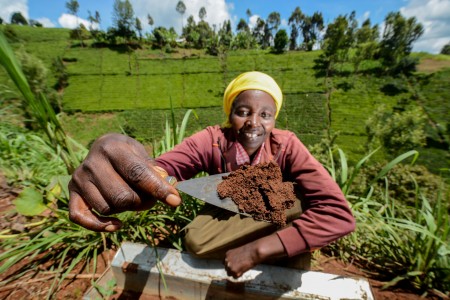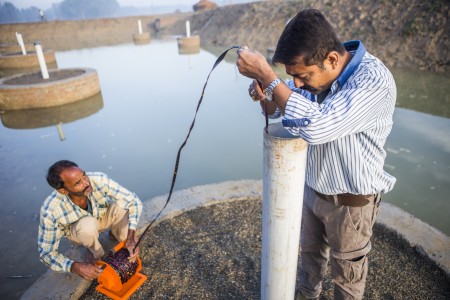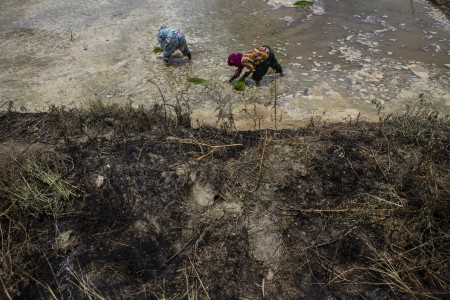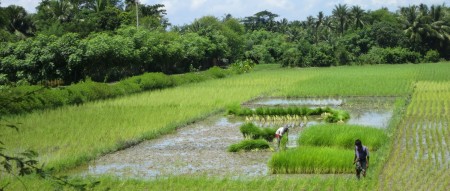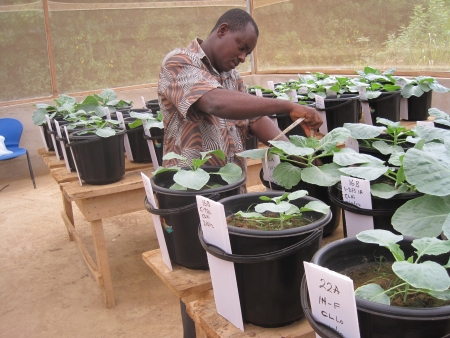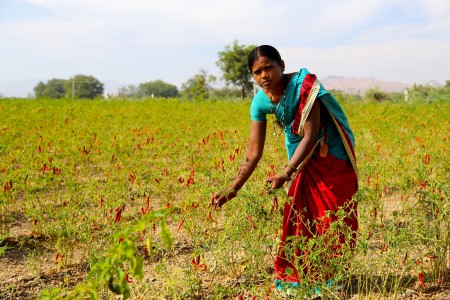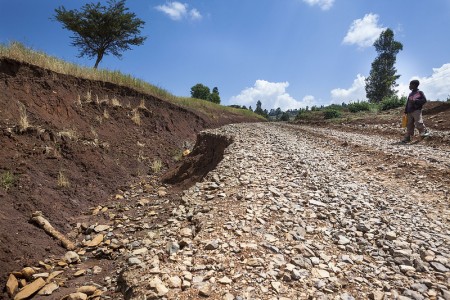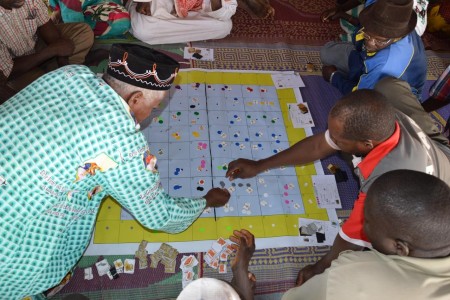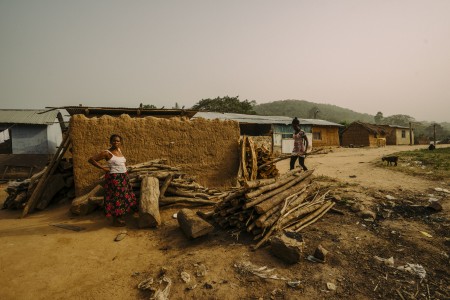The WLE 2016 Annual Report > Facilitating community-led science

Working together to bridge the gender gap in agriculture
Women make essential contributions to agriculture and rural economies in all developing countries. Yet, women's productivity is often constrained by their access (or lack of access) to productive resources such as land, water, and capital. Their contribution is also often constrained by their lack of freedom to play a fully participatory role in decision making about these resources. When women lack access to resources, or are unable to equally participate in decisions about them, they are unable to make investments in agricultural production.
Considering the basic fact that women make up half the population, it can be argued that achieving sustainable intensification of agriculture at scale will depend on women having greater opportunities to contribute. Evidence indicates that reducing or eliminating the gender gap could lead to significant gains for society as a whole. This could be not only in the form of increased agricultural productivity, but also through improved household livelihoods.
WLE has been developing and trialing tools, manuals and other community-led and capacity building approaches with the aim of fostering this beneficial transformation. A very important insight emerging from WLE’s research is that enhancing positive collaboration between men and women will likely lead to better outcomes for everyone.
Improving gender equality for better irrigation management
WLE researchers have successfully developed and piloted the Gender in Irrigation Learning and Improvement Tool (GILIT) in Malawi and Uzbekistan. In Uzbekistan, the International Water Management Institute (IWMI) partnered with irrigation water user associations and Nazar Business and Technology to develop and pilot the GILIT tool on six large irrigation schemes. Similarly, in Malawi, IWMI partnered with the academics from the University of Malawi, the Agricultural Extension Service and smallholder farmers in the Kaziputa and Lufilya irrigation schemes, which have matrilineal and patrilineal inheritance systems, respectively.
The GILIT tool, which is intended to support local governments and other stakeholders in improving gender integration in irrigation scheme planning, identifies policies and operational procedures in formal irrigation schemes that need to be adjusted in order to promote gender equity. GILIT is based on a set of indicators that focus on three critical themes in gender and irrigation: access to resources, participation in decision making, and access to benefits. It also includes supporting discussion questions and an adaptable scoring system.
This is important because evidence suggests that the community-based approaches applied in water management projects do not necessarily lead to greater participation and empowerment of all the stakeholders involved. Commonly used approaches sometimes make the mistake of viewing the community as a single, homogenous entity in which all members generally share common interests and goals. In reality however, men and women (to give just one demographic example) have different needs and priorities when it comes to using and managing resources.
Measuring and facilitating rural women’s empowerment
The Women’s Empowerment in Agriculture Index (WEAI) is one useful tool for monitoring the level of women’s empowerment and inclusion in the agricultural sector. It was developed by the International Food Policy Research Institute (IFPRI) and the International Livestock Research Institute (ILRI) through WLE.
Through WLE, researchers from IWMI have also been working to develop and pilot participatory gender training for community groups in 12 villages of Nepal and India. Working with around 60 field staff from 15 NGOs the WLE team piloted the training with 200 farmers. The techniques and approaches used are captured in the Manual for Critical Discussion on Gender Norms, Roles and Relations.
Through carefully designed activities participants are encouraged to reflect on their own gender perceptions, critically discuss gender roles at home and in the community, and develop bargaining skills through role play. This work was carried out in collaboration with a variety of partners, including SAKHI (Bihar, India), the Centre for the Development of Human Initiatives (West Bengal, India) and iDE Nepal.
Tools for improved access for women in Africa
In West Africa, WLE through IWMI explored how effective a number of agricultural water management solutions have been in delivering multiple ecosystem services, maintaining environmental health and providing returns on investment. Researchers found that improving women’s access to small reservoirs can improve household livelihoods. This can be achieved for example by investing in community-managed small reservoirs and by including women in the planning and management.
This work is a result of a partnership between WLE, IWMI, the Women in Agricultural Development Directorate of the Ghana Ministry of Food and Agriculture, the Kwame Nkrumah University Science and Technology, iDE Burkina Faso and the West African Science Service Center on Climate Change and Adapted Land Use (WASCAL).
WLE has also demonstrated a simple yet innovative socio-hydrological approach using participatory three-dimensional maps to identify gendered ecosystem services in Ethiopia.
In Burkina Faso and Niger, a WLE research team led by ILRI discovered that a number of opportunities exist to increase sustainable productivity, enhance equity, improve incomes and spread the benefits of fodder biomass production more widely. They explored biomass production and management from a gender perspective in communities at two sites in the semi-arid north of the Volta and Niger River basins (four villages in Yatenga province in northern Burkina Faso, and four villages in Fakara district in south-western Niger).
All of these efforts, designed to explore innovative approaches to overcome gender barriers in agriculture in various parts of the globe, are helping to shed light on the path towards achieving inclusive, equitable and sustainable agricultural intensification.
Learn more about WLE's research on enhancing smallholders' livelihoods.
Towards sustainable intensification:
stories of real-world sciencewater, land and ecosystems research highlights
Phase 1
Since its inception in 2012, the CGIAR Research Program on Water, Land and Ecosystem (WLE) has developed scientific evidence and solutions for sustainably intensifying agriculture.
For WLE, sustainable intensification means more than minimizing agriculture’s environmental footprint; it means making sure that agriculture benefits both the planet and its people, providing global populations with food and nutritional security, resilience and livelihoods.
WLE researchers and their partners work across scales, disciplines and sectors to find sustainable, viable ways to transform agriculture, locally and at scale. Discover how the resulting solutions can lead to real-world change by exploring the briefs and stories below to.
New briefs on sustainable intensification
Achieving resilient food systems requires identifying incentives for sustainable farming, developing new policies and institutions, as well as working with diverse stakeholders to test and scale integrated solutions.
The program’s findings so far are summarized in a new series of briefs, Towards sustainable intensification: Insights and solutions.
The series aims to guide and support decision and policy makers, investors and others working to achieve sustainable intensification of agriculture. Each brief is focused on a topic of strategic relevance and provides analysis of and recommendations on how to place sustainability at the heart of agri-food systems.
in 2015 wle: field tested 62 technologies and natural resource management practices, helped 125,000 farmers to apply new technologies or management practices, supported improved technologies or management practices on 2.5 million hectares
Influencing policy and decision making
In 2015 WLE: established 41 multi-stakeholder platforms and influenced 200 policy processes
Promoting innovative business models and institutions
Facilitating community-led science
WLE in 2015 had 110,000 website visits and 43,000 views on CG-space and published 141 ISI publications and 94 open access publications




